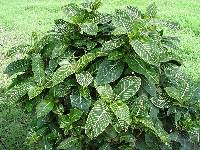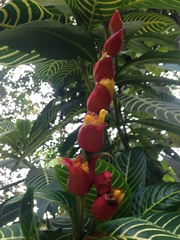
|
Family: Acanthaceae
|
2. Sanchezia speciosa Leonard Sanchezia speciosa Leonard, Journ. Washington Acad. Sci. 16: 490. 1926. The type, collected in the Botanical Garden of Havana, Cuba, January 1905, by A. H. Curtiss, No. 622, is in the U. S. National Herbarium. Plant shrubby; stem quadrangular; leaves oblong-elliptic, 10 to 25 cm. long, 3 to 7 cm. wide (the lowermost probably larger), gradually narrowed to a slender blunt apex, narrowed or rounded at base and decurrent on the petiole, glabrous, the margins undulate, the costa and lateral veins (9 to 12 pairs) prominent beneath, the cystoliths curved, about 0.5 mm. long; inflorescence a terminal simple or forked inter- rupted spike equaling or exceeding the upper pair of leaves; inter- nodes 1 to 3 cm. long; flowers (3 or more) borne in bracted fascicles 1 to 2 cm. broad; bracts ovate, blunt at apex, glabrous, bearing cysto- liths; bractlets oblong-elliptic, about 2 cm. long and 8 mm. wide, ob- tuse; sepals ligulate, 1.5 to 1.8 cm. long, 3 to 5 mm. wide, rounded at apex; corolla orange, the tube 4 to 6 cm. long, 7 to 8 mm. broad at throat, narrowed below the middle to 3 mm., glabrous, the lobes 3 to 4 mm. long, rounded, emarginate; stamens inserted about 5 mm. above the base of the corolla tube, the filaments 4 to 4.5 cm. long, exserted 5 to 15 mm. beyond the mouth of the corolla, sparingly pilose; anthers 5 mm. long; staminodes 2.5 cm long; style 5 cm. long, equaling or exceeding the stamens; fruit not seen. Usually found in cultivation but undoubtedly a plant of wet forests when growing in its natural haunts. The fact that the Putumayo specimen was collected from a plant growing wild is of great interest, since all the other material in the U. S. National Herbarium is from cultivated sources. West Indies and Colombia. PUTUMAYO: On the left bank of Quebrada de la Hormiga along the Río San Miguel, Cuatrecasas 11109 (US). 2. Sanchezia speciosa Leonard Sanchezia speciosa Leonard, Journ. Washington Acad. Sci. 16: 490. 1926. The type, collected in the Botanical Garden of Havana, Cuba, January 1905, by A. H. Curtiss, No. 622, is in the U. S. National Herbarium. Plant shrubby; stem quadrangular; leaves oblong-elliptic, 10 to 25 cm. long, 3 to 7 cm. wide (the lowermost probably larger), gradually narrowed to a slender blunt apex, narrowed or rounded at base and decurrent on the petiole, glabrous, the margins undulate, the costa and lateral veins (9 to 12 pairs) prominent beneath, the cystoliths curved, about 0.5 mm. long; inflorescence a terminal simple or forked inter- rupted spike equaling or exceeding the upper pair of leaves; inter- nodes 1 to 3 cm. long; flowers (3 or more) borne in bracted fascicles 1 to 2 cm. broad; bracts ovate, blunt at apex, glabrous, bearing cysto- liths; bractlets oblong-elliptic, about 2 cm. long and 8 mm. wide, ob- tuse; sepals ligulate, 1.5 to 1.8 cm. long, 3 to 5 mm. wide, rounded at apex; corolla orange, the tube 4 to 6 cm. long, 7 to 8 mm. broad at throat, narrowed below the middle to 3 mm., glabrous, the lobes 3 to 4 mm. long, rounded, emarginate; stamens inserted about 5 mm. above the base of the corolla tube, the filaments 4 to 4.5 cm. long, exserted 5 to 15 mm. beyond the mouth of the corolla, sparingly pilose; anthers 5 mm. long; staminodes 2.5 cm long; style 5 cm. long, equaling or exceeding the stamens; fruit not seen. Usually found in cultivation but undoubtedly a plant of wet forests when growing in its natural haunts. The fact that the Putumayo specimen was collected from a plant growing wild is of great interest, since all the other material in the U. S. National Herbarium is from cultivated sources. West Indies and Colombia. PUTUMAYO: On the left bank of Quebrada de la Hormiga along the Río San Miguel, Cuatrecasas 11109 (US). |









